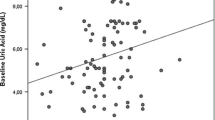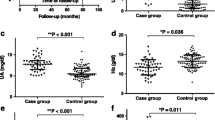Abstract
Background
High uric acid level is a known risk factor for deterioration of renal function in chronic kidney disease (CKD), but its influence on the progression of IgA nephropathy (IgAN) remains unclear.
Methods
Adult IgAN patients (n = 611) were classified according to CKD stage. Renal survival rates and clinical and histological findings were compared between patients with high (H-UA) and normal (N-UA) uric acid levels in different CKD stages.
Results
The proportion of patients with H-UA increased significantly with increasing CKD stage (stage G1, 12.3 %; stage G2, 19.0 %; stage G3a, 43.7 %; stage G3b–4, 69.0 %; P < 0.001). The 30-year renal survival rate was similar in patients with H-UA and N-UA in CKD stages G1, G2, and G3b–4, but was significantly lower in patients with H-UA than with N-UA in CKD stage G3a (24.7 vs. 51.9 %; P = 0.0205). The clinical findings were similar in patients with H-UA and N-UA, but the interval from onset to biopsy differed between groups. The proportion of patients with global sclerosis was significantly higher in patients with H-UA than with N-UA in CKD stage G3a (33.3 vs. 11.4 %; P = 0.0005), but the Oxford classifications were similar between groups. Multivariate Cox regression analysis identified H-UA (HR 1.36, 95 % CI 1.07–1.72, P = 0.011) and a large amount of proteinuria (HR 1.38, 95 % CI 1.09–1.74, P = 0.0084) as independent predictors of end-stage renal disease.
Conclusions
H-UA induced global glomerular sclerosis and accelerated the progression of IgAN in CKD stage G3a.


Similar content being viewed by others
References
Moriyama T, Tanaka K, Iwasaki C et al (2014) Prognosis in IgA nephropathy: 30-year analysis of 1,012 patients at a single center in Japan. PLoS ONE 9:e91756
Ryoo JH, Choi JM, Oh CM, Kim MG (2013) The association between uric acid and chronic kidney disease in Korean men: a 4-year follow-up study. J Korean Med Sci 28:855–860
Sedaghat S, Hoorn EJ, van Rooij FJA et al (2013) Serum uric acid and chronic kidney disease: the role of hypertension. PLoS ONE 8:e76827
Miyaoka T, Mochizuki T, Takei T, Tsuchiya K, Nitta K (2014) Serum uric acid levels and long-term outcomes in chronic kidney disease. Heart Vessels 29:504–512
Matsuo S, Imai E, Horio M, Yasuda Y et al (2009) Revised equation for estimated GFR from serum creatinine in Japan. Am J Kidney Dis 53:982–992
Cattran DC, Coppo R, Cook HT, A Working Group of the International IgA Nephropathy Network and the Renal Pathology Society et al (2009) The Oxford Classification of IgA Nephropathy: rationale, clinicopathological correlations, and classification. Kidney Int 2009:534–545
Roberts IS, Cook HT, Troyanov S, A Working Group of the International IgA Nephropathy Network and the Renal Pathology Society et al (2009) The Oxford classification of IgA nephropathy: pathology definitions, correlations, and reproducibility. Kidney Int 76:546–556
Johnson RJ, Nakagawa T, Jalal D, Sánxhez-Lozada LG, Kang DH, Ritz E (2013) Uric acid and chronic kidney disease: which chasing which? Nephrol Dial Transplant 28:2221–2228
Ohno I (2011) Relationship between hyperuricemia and chronic kidney disease. Nucleosides Nucleotides Nucleic Acid 30:1039–1044
Syrjänen J, Mustonen J, Pasternack A (2000) Hypertriglyceridaemia and hyperuricemia are risk factors for progression of IgA nephropathy. Nephrol Dialysis Transplant 15:34–42
Ohno I, Hosoya T, Gomi H, Ichida K, Okabe H, Hikata M (2001) Serum uric acid and renal prognosis in patients with IgA nephropathy. Nephron 87:333–339
Myllymäki J, Honkanen T, Syrjänen J, helin H, Rantala I, Pasternack A, Mustonen J (2005) Uric acid correlates with the severity of histological parameters in IgA nephropathy. Nephrol Dial Transplant 20:89–95
Shi Y, Chen W, Jalal D et al (2012) Clinical outcome of hyperuricemia in IgA nephropathy: a retrospective cohort study and randomized controlled trial. Kidney Blood Press Res 35:153–160
Sulikowska B, Manitius J, Odrowąż-Sypniewska G, Łysiak-Szydłowska W, Rutkowski B (2008) Uric acid excretion and dopamine-induced glomerular filtration response in patients with IgA nephropathy. Am J Nephrol 28:391–396
Sulilpwska B, Johnson RJ, Odrowąż-Sypniewska G, Manitius J (2012) Uric acid, renal vasoconstriction and erythropoietin relationship in IgA nephropathy revealed by dopamine-induced glomerular filtration response. Kidney Blood Press Res 35:161–166
Cheng GY, Liu DW, Zhang N, Tang L, Zhao ZZ, Liu ZS (2013) Clinical and prognostic implications of serum uric acid levels on IgA nephropathy: a cohort study of 348 cases with a mean 5-year follow-up. Clin Nephrol 80:40–46
Zhou J, Chen Y, Liu Y et al (2014) Plasma uric acid level indicates tubular interstitial lesions at early stage of IgA nephropathy. BMC Nephrol 15:11
Conflict of interest
All authors declare no conflicts of interest.
Author information
Authors and Affiliations
Corresponding author
Rights and permissions
About this article
Cite this article
Moriyama, T., Itabashi, M., Takei, T. et al. High uric acid level is a risk factor for progression of IgA nephropathy with chronic kidney disease stage G3a. J Nephrol 28, 451–456 (2015). https://doi.org/10.1007/s40620-014-0154-0
Received:
Accepted:
Published:
Issue Date:
DOI: https://doi.org/10.1007/s40620-014-0154-0




